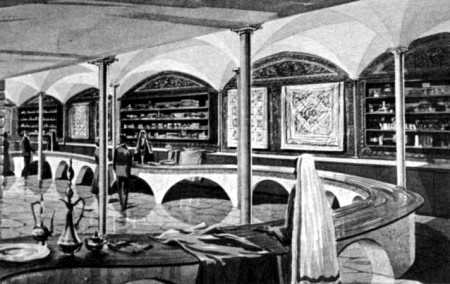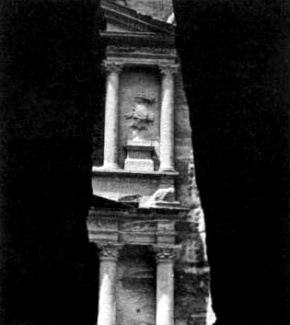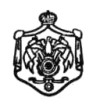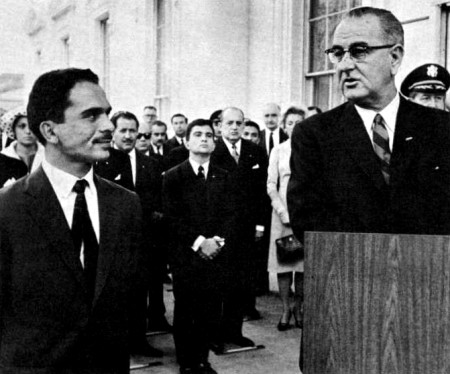|

H. M. King Hussein Opens Jordan's
Holy Land Pavilion at N. Y. Fair
|
His Majesty King Hussein opened today the
"Pavilion of Jordan, They Holy Land," in a ceremony
attended by Mayor Wagner of New York, General Manager of the
World's Fair Robert Moses, Jordanian Ambassador Abdel Moneim
Rifai and many other dignitaries.
KING HUSSEIN
 |
|
King Hussein, who is on an official ten-day
visit to the United States, said his country was proud to bring
to the American people a part of Jordan's history and culture,
and thanked the Fair authorities for the kind cooperation and
help extended to the Jordan pavilion.
The young Jordanian monarch added: "My
country will not be able to exhibit atomic power, or a special
mechanical energy, or an advanced electrical device, But we will
be quite able to exhibit that which shall remain when everything
else shall vanish. We, who have within our heritage people like
Jesus Christ and Mohammed the Prophet, must be represented by
a scheme that reflects the ideals of our life and the simplicity
of our nature. In our pavilion the Ten Commandments shall echo,
the birth of Jesus Christ shall shine, and the ascendance of
Mohammed shall be reflected. In our pavilion, the oldest Torah;
the Church of the Nativity, and the Mosque of the Dome of the
Rock, shall stand symbols of righteousness, tolerance, peace
and brotherhood."
The Dead Sea Scrolls, among the greatest treasures
of the world, will be exhibited in the Jordan pavilion. As a
salute to the city of New York, the Jordanian Government will
offer a 2,000 year old Roman column, for permanent display in
a New York public park. The column from the ancient city of Jerash,
will be placed before the pavilion during the Fair.
|

Pavilion Captures Charm and Spirit
|
Covering an area of 6,500 square feet, the
Pavilion of Jordan is one of the most original and striking in
the whole of the New York World'sFair. commenting on its conception,
the brilliant Jordanian architect Victor Bisharat said, "On
considering the area and budget allotted to build the pavilion,
I felt I had two choices: either to erect a small building or
mould a huge sculpture, I decided to mould a huge sculpture."
The most dramatic feature of the Jordanian
pavilion is the rolling roof made of reinforced concrete cast
as one piece and covered with gold mosaic. Describing this spectacular
design Bisharat said, "I wanted to capture the image of
the rolling domes of old Jerusalem, the spires of the magnificent
cathedrals, the rounded roofs of the Byzantine churches, the
rolling sand dunes of the Jordan desert, the beautiful
|
mosques and biblical catacombs. I believe
my sculpture achieves this to a great extent.
Another major feature of this truly abstract
symbolic edifice is a series of stained glass windows depicting
in a colorful and awe-inspiring manner the Via Dolorosa or the
14 Stations of the Cross. The stained glass pictures, making
up most of the outer walls of the pavilion, were done by the
famous Spanish artist Antonio Soura.
Inside the pavilion most of the illumination
comes from tinted glass sky lights of different sizes which with
the wave-like rolling roof give an aura of mystery and enchantment.
The colors depict Jordan as a land of sun, sand and blue skies.
|
Pavilion Briefs
|
|
|
Jordan Girls Greet Visitors
|

|
|
On hand to serve you at the Jordan pavilion
will be eleven girls serving as information officers - dressed
in colorful national consumes and all experts on the historical
and cultural traditions of their country. The eleven hostesses
all came from Jordan especially for the Fair.
In charge of the young ladies from Jordan
is Mrs. Sami Awad, wife of the Tourist and Press Attache of Jordan.
Mrs. Awad has been living in the Untied States for two years
and will use this experience to acquaint the newly arrived girls
with the American way of life. They are also expected to make
the best of their two year stay in the United States by attending
|
American colleges and universities in their
spare time and during the winter months when the Fair will be
closed.
Of the ten girls who are assisting Mrs. Awad,
two are from Jerusalem: the Misses Dyala Husseini and Doris Salah;
five are from Jordan's capital, Amman: the Misses Leila Deeb,
Sumaya Kuleini, Sumaya Bitar, Nuyassar Abu Dabbeli, and Renata
Bushnaq. Miss Jane Kattan is from Bethlehem, Miss Hayam Dajani
is from Irbid, and Mrs. Muna Doani is from Ramallah. All the
girls speak excellent English as well as Arabic, and nearly all
of them have a third language as well: French, German, Italian
or Spanish.
|
|
|
-
Legacy of the
-
Dead Sea Scrolls
 |
The Dead Sea Scrolls, one of the greatest
historical discoveries of the century, will be on public display
for the first time in the United States at the Jordan pavilion.
The discovery of these scrolls is an interesting
story by itself. Khirbet Qumran the region which unlocked the
mystery of the Dead Sea Scrolls is situated on an ancient site,
on the Northwest Coast of the Dead Sea.
The ruins are at the foot of a rough and rugged
cliffs. In the background are the impressive mountains of Moab,
craggy and silent and undergoing a continuous change of colors.
|
The discovery of the scrolls occurred by sheer
coincidence in the spring of 1947. They were found by a Bedouin
shepherd searching for one of his lost sheep.
The scrolls belonged to the Essene Community,
who parted from Orthodox Judaism in Jerusalem and came to the
arid wilderness of Qumran in the second half of the second century.
It appears their caves and tents were destroyed by an earthquake
that shook Judaea in 31 B.C. and forced them to flee the region.
They returned in 4 B.C. and continued to live in Qumran until
68 A.B. when they fell victim to the Roman legions which were
heading towards Jerusalem. The Romans completely destroyed the
Essene tribe. The Community then sank beneath the surging tide
of history for 19 centuries, leaving nothing but a dim tradition
in the mists of time.
The 2,000 year-old scrolls were the biblical
manuscripts of the Essene Community. More than 600 manuscripts
were found in eleven caves in Qumran. Other scrolls of a later
date, were found south and west of this region.
The scrolls demonstrated how these people
"spent their life studying the Holy Writ and praying for
the coming of the Messiah." They also reflected the life
of this desert settlement which paved the way for the teachings
of Jesus.
There is no doubt that the Dead Sea Scrolls
contribute greatly to the understanding of the Old Testament
and are of invaluable historical significance. The Scrolls are
now kept in the Palestine Archaeological Museum in Arab Jerusalem.
|
|
- Jordan Pipers, Band
- At Fair Opening
|
- Jordan Merchants to
- Run Unique Bazaar
|
|
One of the most spectacular military musical
organization is the world, the Jordan Army Band and the Jordan
Corps of Pipers, will be on hand when His Majesty, dedicates
the Jordan Pavilion at the World's Fair. Recently arrived from
Jordan, the band and the pipers will remain in the United States
for approximately one month, and will give daily performances
at the Fair when they are in New York. They are also contemplating
a tour of American cities if their tour can be extended.
The Corps of Pipers is the older of the two
sections of the army's musical group, having been founded in
1921, whereas the Jordan Army Band was not organized until 1925.
Both units total 46 in number, and their parade uniforms, featured
by the famous Arab headdress, the keffieh, are as colorful as the Grenadier Guards.
The Jordan Army Band and the Corps of Pipers
have made many appearances outside Jordan. In 1954 they made
a three month tour of Great Britain; in in 1959, they were a
feature attraction at the Bari, Italy, military band festival.
They have also appeared in the United Arab Republic, Lebanon
and Syria; and have made concert tours in Iran and Turkey.
Perhaps their most sensational appearance
was at the Edinburgh Festival last year, when they scored a spectacular
triumph in competition with many of the most famous musical organizations
in the world.
|
Six of the leading merchants of Jerusalem
and Bethlehem have formed a consortium in order to provide the
pavilion at the World's Fair with a wide variety of handicraft
products from the Holy Land. The bazaar, souk as it is
known in the Arab world, is located in the basement of the pavilion,
and will feature such authentic souvenirs of the Holy Land as
Bibles bound in olive wood or mother of pearl, and figures for
creches made of olive wood.
In addition to these beautiful hand-made objects,
the different shops in the souk will have available Crusader
jackets, embroidered objects of all kinds, Crusader crosses,
and other religious objects.
There will be a special section devoted to
metal objects of all kinds particularly gold and silver jewelry,
as well as trays, candlesticks, and crucifixes. Another booth
in the bazaar will feature the famous ceramic tiles and pottery
which are made in Jerusalem.

|
Documentary Films in Jordan Theatre
|
A series of outstanding films on Jordan will
be on continuous schedule daytime and evening in the little theater
in the basement of the Pavilion. One of them, "Ahlan Wasahlem"
or "Welcome to Jordan," was made especially for the
Fair by United States Productions, and features His Majesty,
King Hussein. The film was directed by the well know cameraman,
Tom Hollyman and was produced by Alfred Butterfield, well know
for his "Secrets of the Reef."
Another in the series rated by critics as
"outstanding among travel documentaries" is "This
Is Jordan," a United Artists release. This has played to
millions of movie-goers in England, and is being shown for the
first time in the U.S. in the pavilion theater.
|
A third film of unusual quality is "Jordan
Today," a film which covers old and new in the life of Jordan.
It was made by Horizon Pictures at the same time that they were
making the Oscar-winning picture, "Lawrence of Arabia."
Although a good deal of it was filmed in the spectacularly scenic
desert area that was featured in the Lawrence film, "Jordan
Today" covers fully the great cities and sites of the Holy
Land.
Three other films on the religious, archaeological
and tourist aspects of Jordan complete the film program. Filmed
in Jordan by an Italian company, all three films have had wide
screenings in European theaters.
|
|
King Hussein Meets U.S. President
|

|
|
Highlight of His Majesty, King Hussein's visit
to the United States, which enabled him to be present a the opening
of the Jordan Pavilion at the World's Fair was the series of
visits he had with President Lyndon B. Johnson in Washington.
The President first received Hussein on the White House lawn
after his arrival there by helicopter. There followed a private
meeting that morning, a state dinner that night, and the following
day a meeting to issue a joint communique.
During his two-week stay in the United States,
King Hussein made several public appearances, including luncheon
meeting with the Citizens Committee for the Commercial Club of
Chicago. He was honored at several dinners, among them the Near
East Foundation and the Foreign Policy Council in New York. Besides
meeting with high government officials in Washington, King Hussein
had private meetings also with Untied Nations Secretary General
U Thant and U.S. Ambassador to the United Nations, Adlai Stevenson.
Among other activities His Majesty engaged
in were visits to Cape Kennedy in Florida, the ranch of oilman
John Mecome outside Houston, and the State of Colorado as guest
of the Governor.
|
|

SOURCE: Jordan
News and Views, Vol. 1 - No. 1, April 1964 - Published by
The Jordan Information Center, New York, N.Y.
|
The Hashemite Kingdom of Jordan, as it is
presently constituted first came into existence in 1950. It comprises
the former Kingdom of Transjordan (the land east of the Jordan
River), which became a sovereign state on March 22, 1946, when
by treaty the United Kingdom terminated its mandate, and that
portion of Palestine and the Dead Sea which was under Jordanian
control when hostilities with Israel ended in 1949.
Jordan has an area of about 37,500 square
miles with a population of approximately 1.7 million.
Jordan is virtually landlocked except for
its southern port of Aqaba, which opens into the Red Sea. On
the north, it is bounded by the Syrian Arab Republic and on the
west by Israel. On the east and south it shares common desert
frontiers with Iraq and Saudia Arabia.
Of its present population of 1.7 million,
one-third are natives of Trans Jordan, one-third are original
residents of the incorporated territory west of the Jordan River,
and the remaining third - some 630,000 - are Palestinian Arab
refugees. With the exception of the two largest cities, Amman
and Zarqa, which lie east of the Jordan river, the urban population
- about 47 per cent of the total - lives primarily on the river's
west bank.
Arabic is the official language and Islam
the official religion. The Constitution, however, guarantees
religious freedom, and there is a long-established Christian
minority of 180,000.
The Constitution of 1952 provides for a parliamentary
form of government with a hereditary monarchy.
|
Introducing Jordan
The people are the source of all powers. King
Hussein I, the present monarch, ascended the throne in May 1953,
succeeding his father, Talal.
The country is predominantly agricultural,
with limited natural resources and a high rate of population
growth. About 80 per cent of the arable land (4 million acres
on 17 per center of the total area) is under cultivation, but
productivity is dependent upon each year's uncertain rainfall.
Principal crops are wheat, barley, millet, maize, sesame, beans,
tobacco, figs, grapes, and olives. Fresh fruits, vegetables and
olive oil are the most important export products. Livestock raising,
particularly of sheep and goats, adds significantly to the country's
economy.
Mineral resources are unimportant, with the
exception of phosphate mined near Amman and Hasa and potash extracted
from the Dead Sea. Phosphate production increased in 1962 and
accounted for 38 per cent of the total value of Jordan's exports.
The Jordan River, together with its principal
tributary stream, the Yarmuk River, constitutes the country's
greatest natural asset. By effectively harnessing this important
river system, Jordan can increase its agricultural productivity
and develop its hydroelectric power and thus lay the foundation
for economic and social progress.
A seven-year plan adopted by Jordan's Development
Board covering 1963-70 is expected to expand production and income
and cut unemployment. Investment will be primary in irrigated agriculture,
|
water - resources development, tourism, and
the exploitation of phosphate and potash. Meanwhile individual
development projects have been making progress.
In 1960 a Central Water Authority was established
to coordinate the development of the water resources of the entire
country.
Jordan has developed a good transportation
network. An all-weather road from Amman to the port city of Aqaba
was completed more than two years ago, and other highways connecting
the capital with Jordan's important urban centers and roads to
Syria and Lebanon have also been completed. Facilities at the
port of Aqaba have also been improved.
One of the most important economic development
projects undertaken by the government in 1958 was the East Ghor
irrigation project, which will divert part of the water of the
Yarmuk River on the Syrian-Jordan border through a system of
diversionary and water-carrying canals to land along the east
bank of the Jordan River. Stage I of this project which is being
financed largely with U. S. assistance, will irrigate some 25,000
acres of land when fully completed. An impressively high productivity
per acre is already apparent in the first section of stage I,
which came under irrigation in the spring of 1962. It is believed
that present production can be doubled with further experience
and technical assistance in the proper use of water, fertilizer
and good farming methods.

|
|